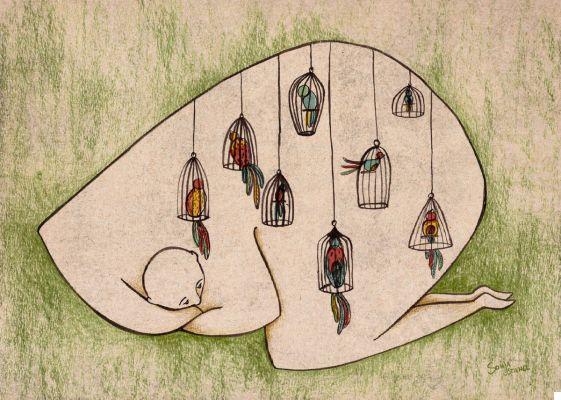
The discrepancies are not bad. What's bad is not knowing how to disagree. Attacking those who think differently. Exclude the dissenter. To close ourselves off to confrontation only because it questions what we believe in.
Instead, Socratic dialogue facilitates a respectful confrontation between two people who use compelling arguments that promote reflection and reasoning to reach the most accurate answer possible. Both people have the opportunity to practice the art of dissent. Openly.
However, we are neither Socrates nor are we in classical Athens. We live in an increasingly polarized society where people are attacked more than their arguments with the aim of imposing a truth that limits critical thinking. Therefore, it is not surprising that discussions quickly degenerate into personal insults and attacks.
Identifying ourselves excessively with ideas, believing that we are what we think
It is not unusual to find ourselves having a heated discussion with someone about something we are not sure enough about or about which we do not have enough information. It is likely that later, with a cool head, we realize that we have exaggerated. We took his words as a personal attack, as if the mere fact of disagreement implied that the other had become our enemy.
Emotions are a huge obstacle that keeps us from respectfully disagreeing. When words fly through the air like remote-controlled darts they hit our reptilian brain, even before we are fully aware of their meaning. Then the emotions take over and the reason goes out.
The words that we classify as "dangerous" and that trigger this process of emotional abduction are those that "attack" our identity. The problem is that when we over-identify with our ideas, anything that questions them is perceived as a personal attack.
If we believe we are what we think, when someone disagrees and questions some of our deepest beliefs, we perceive it as an attack on our "I". We are unable to take the necessary psychological distance, so emotions take over and we respond without logic or arguments. Therefore, in order to master the art of dissent we must maintain a certain equidistance from our ideas.
When the discrepancy is perceived as a betrayal
We don't give the same value to all words. Dissent that comes from our innermost circles of trust, or from groups with which we feel identified, can be more painful and generate more intense emotional reactions. We do not take the words of a person who does not know us on social media as seriously as the criticisms of a friend.
We have to start from the fact that opinions, ideas and narratives help us determine "who is on our side". They are a kind of indicators that tell us more or less reliably who we can trust and who we can't.
Therefore, while it may seem paradoxical, the price to pay for disagreement can be lower when we disagree with people who don't think like us and are not part of our circle of trust or the groups we identify with.
What is really difficult is learning to disagree with those around us, with the group that welcomes us and of which we feel we belong, the group in which we place our affections and in which we trust to support us when things go. bad. Dissent in this group is often perceived as a personal betrayal that is difficult to manage.
This is confirmed by a study conducted at Monash University, in which it was appreciated that when we have to disagree with those closest to us, we can experience strong cognitive dissonance. Basically, our brain reacts as if the other's ideas were ours, which generates that internal split that causes anxiety.
Levels of discrepancy, from insult to rebuttal
We are all full of contradictions. We need contact with others, as well as some degree of social approval and validation. We need to feel part of the group. But we also need to feel unique and different. This is why we feel the need to disagree. We self-assert ourselves through differences, literally or symbolically.
In this social dialogue it is normal for us to oscillate between agreement and disagreement. In fact, the brightest and most innovative ideas usually arise from dissent, it is an open window to new ways of seeing and understanding the world. But we must learn to disagree with respect and logic because only in this way does positive change happen.
Essayist Paul Graham has determined a number of levels of disagreement that can guide us on the path of respectful dissent, also allowing us to identify people who disrespect us in this exchange of ideas.
• Insults. It is the lowest form of disagreement and probably the most common. In this case there is no rationality or argumentation because dissent is based on insult. You don't even pay attention to the idea, you go straight to the insults in a rude way, thus preventing any possibility of dialogue.
• An argument with a person. It is a form of dissent in which compelling reasons are not given, but the person is attacked directly for who he is or for his actions, which are completely irrelevant to the case. In practice, instead of refuting the arguments, those who resort to the argumentum ad hominen limit themselves to saying that the other lacks authority because he does not move in respectable circles or has used drugs, for example.
• Response to tone. In this case the argument is not attacked, but the tone that the other person used. Instead of indicating the error in the opposite reasoning, the person simply attacks the arrogant, frivolous or angry tone. Therefore, the central idea is not refuted, but the attack is directed at the forms.
• Contradiction. At this level of dissent, you stop attacking the person to focus on the idea under discussion. However, the argument against merely presents an opposite idea with little or no justification. In practice, the person simply says otherwise, but without providing any evidence to support his claim.
• Counter-argument. It is the first compelling form of disagreement that tries to prove something. The problem is that the counter-argument is usually a contradiction rather than an argument in itself since it usually touches on a different subject. For example, given the idea that "children need toys to develop their skills", a counter-argument will indicate that "the most important thing is the love, attention and care that children receive". In this case, even if the counter-argument is true, it does not refute the primary idea.
• Refutation. The most convincing form of disagreement is refutation, although it is also the rarest, because it requires more intellectual work. In this case we start from the arguments of the other to explain why his thesis does not hold up. It consists of finding the error in a topic and explaining it using data, giving reasons or using evidence.
In any case, in order to successfully practice the art of dissent, it is important that we focus on refuting the central point, avoiding going around it so as not to fall into useless and irrelevant discussions. Once we have identified the central idea that the discussion is about, we need to look for solid arguments to refute it.
We must remember that in the social sea in which we swim, it is not always easy to orient ourselves and we are often not fully aware of the currents that push us in one direction or the other. Nonetheless, the art of disagreement consists in exercising our freedom to discrepancy by allowing the other to exercise it as well.
After all, disagreeing comes from the Latin word “discrepāre”, which means to sound differently or have a different opinion. It does not imply being right or in possession of the truth, but only presenting a different point of view that can offer a different perspective on the complex issues of the world.


























